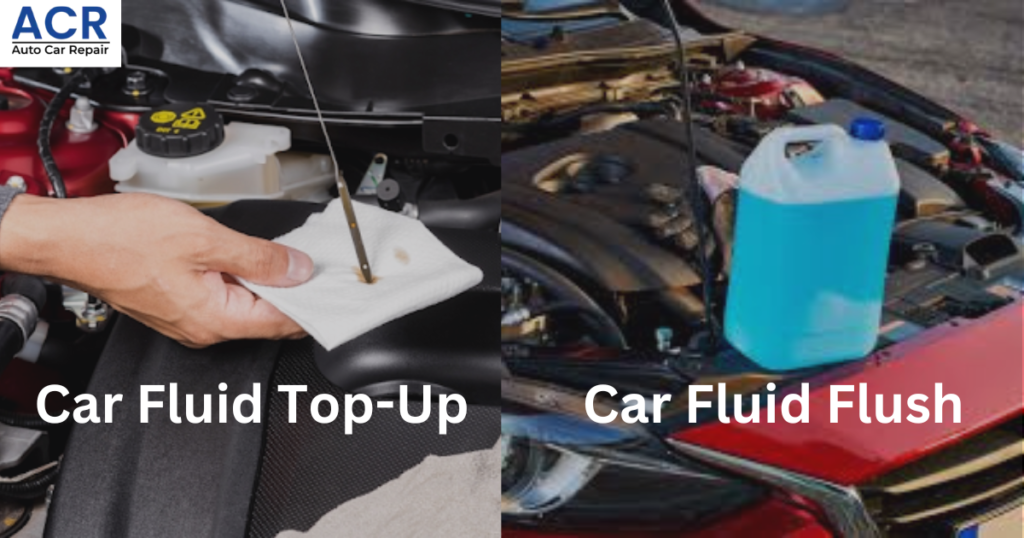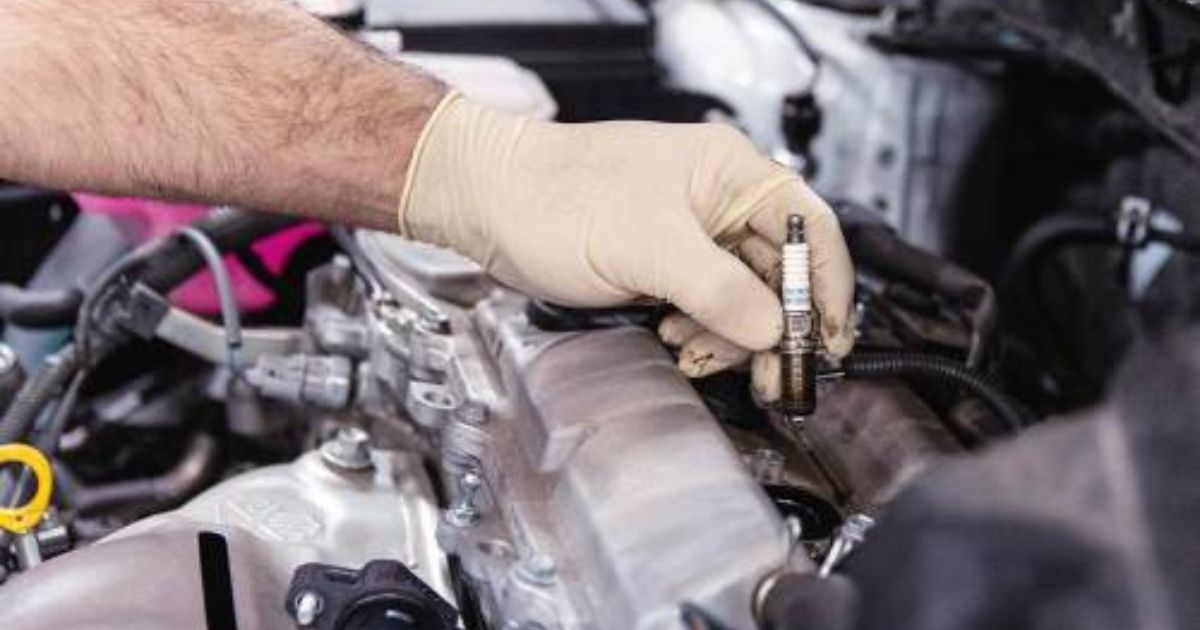Car fluid flush and car fluid top-up both contribute to the optimal performance and safety of your car on the road.
Car fluids play an essential role in maintaining the health of the car engine by lubricating components and regulating the temperature within the engine chamber. Regular car fluid maintenance helps prevent overheating, corrosion, and component wear.
Inspecting fluid levels, flushing contaminated fluids, and topping fluids to recommended levels are a part of regular car engine service. However, it is important to understand the difference between fluid flush and fluid top-up for availing of the right service for your car.
Auto Car Repair (myTVS) is a multi-brand car service center in Delhi NCR catering to a wide range of car repair and maintenance services.

What are the Different Types of Car Fluid?
Various types of fluids are essential for the proper functioning of a car’s systems. Each fluid plays a crucial role in the proper operation and maintenance of a vehicle.
Find below the essential car fluids:
Engine Oil: Engine oil lubricates moving parts within the engine, reducing friction and preventing wear. It also helps to cool the engine by absorbing heat.
Coolant/Antifreeze: Coolant regulates the temperature of the engine by absorbing heat and dissipating it through the radiator. It prevents the engine from overheating in hot conditions and freezing in cold weather.
Transmission Fluid: Transmission fluid lubricates the gears and components of the transmission, allowing for smooth gear shifts and reducing wear on transmission parts.
Brake Fluid: Brake fluid transmits hydraulic pressure from the brake pedal to the brake calipers or wheel cylinders, enabling the braking system to function effectively.
Power Steering Fluid: Power steering fluid assists in the operation of the power steering system, making it easier to turn the steering wheel.
Windshield Washer Fluid: Windshield washer fluid is used to clean the windshield, removing dirt, bugs, and other debris for improved visibility while driving.
Regular inspection and maintenance of these fluids are essential to ensure the vehicle’s performance, efficiency, and longevity.
What is a Car Fluid Flush?
A car fluid flush is a maintenance procedure that involves completely draining the existing fluid from a vehicle’s system and replacing it with fresh fluid. This process is typically performed to remove old, degraded fluid and any accumulated contaminants or debris from the system. Car fluid flushes are commonly carried out on systems such as the engine cooling system, transmission, brakes, and power steering.
Types of Car Fluid Flushes:
Coolant Flush: A coolant flush involves draining the old coolant from the engine cooling system. Then, it is flushed with clean water or a specialized cleaning solution before being refilled with fresh coolant. This process helps maintain proper engine temperature regulation and prevents overheating.
Transmission Fluid Flush: A transmission fluid flush removes old, degraded fluid and any accumulated contaminants from the transmission system. This helps ensure smooth gear shifts and optimal transmission performance.
Brake Fluid Flush: A brake fluid flush removes old brake fluid from the brake lines and replaces it with fresh fluid. This process helps maintain proper braking function and prevents brake system corrosion and failure.
Power Steering Fluid Flush: A power steering fluid flush involves removing old fluid from the power steering system and replacing it with fresh fluid. This helps maintain smooth steering operation and prevents power steering system failure.
Engine Oil Flush: An engine oil flush involves using a specialized cleaning solution to remove sludge, debris, and contaminants from the engine’s oil passages and components. This process helps ensure proper lubrication and prolongs engine life.
Each type of car fluid flush is essential for maintaining the performance, efficiency, and longevity of the vehicle’s systems. Regular flushing of these fluids helps prevent issues such as overheating, transmission failure, brake system malfunction, power steering problems, and engine damage.
Signs Your Car Needs a Fluid Flush:
Discolored Fluid: If you notice that the fluid in your car’s reservoir appears dark, cloudy, or discolored, it may indicate the presence of contaminants or degradation. This is a sign that a flush may be needed to remove the old fluid and replace it with fresh fluid.
Foul Odors: Unusual smells emanating from your car’s fluid reservoirs, such as a burnt odor from transmission fluid or a sweet smell from coolant, may indicate the presence of contaminants or degradation. This is another sign that a car fluid flush may be necessary to maintain proper system function.
Reduced Performance: If you experience decreased system performance, such as overheating, rough shifting, or diminished braking effectiveness, it could indicate that your car’s fluids are contaminated or degraded. In such cases, a fluid flush may be required to restore optimal system operation.
Manufacturer Recommendations: Additionally, it’s essential to follow the manufacturer’s recommendations for car fluid flush intervals outlined in your car’s owner’s manual. These intervals are based on factors such as driving conditions, mileage, and climate. Ensure that your car’s fluids are properly maintained for optimal performance and longevity.
A car fluid flush involves draining the existing fluid from a vehicle’s system and replacing it with fresh fluid to remove contaminants and maintain proper system function. Regular fluid flushes are essential for ensuring the longevity and performance of your vehicle’s systems.
What is a Car Fluid Top-Up?
A car fluid top-up is a maintenance procedure that involves adding additional fluid to a vehicle’s reservoir or system to replenish the fluid level. This task is typically performed when the fluid level has dropped below the recommended level due to normal usage or minor leaks.
Types of Car Fluid Top-Ups:
Engine Oil Top-Up: Engine oil is essential for lubricating engine components and reducing friction. Over time, engine oil levels may decrease due to consumption or minor leaks. Topping up the engine oil ensures proper lubrication and protects the engine from damage.
Coolant Top-Up: Coolant helps regulate engine temperature and prevent overheating. Loss of coolant due to evaporation or minor leaks can lead to decreased coolant levels. Topping up the coolant maintains proper engine cooling and prevents overheating.
Power Steering Fluid Top-Up: Power steering fluid assists in steering and ensures smooth operation of the power steering system. Low power steering fluid levels can result in difficulty steering or increased steering effort. Topping up the power steering fluid restores proper steering functionality.
Brake Fluid Top-Up: Brake fluid transmits hydraulic pressure to the brakes, enabling effective braking. Loss of brake fluid due to evaporation or minor leaks can lead to decreased braking performance. Topping up the brake fluid ensures proper brake function and safety.
Signs Your Car Needs a Fluid Top-Up:
Dashboard Warning Lights: Warning lights, such as the engine oil pressure light or coolant temperature light, may illuminate if fluid levels are low, indicating the need for a car fluid top-up.
Fluid Leaks: Visible fluid leaks underneath the vehicle or around fluid reservoirs may indicate low fluid levels and the need for a top-up.
Reduced Performance: Decreased performance, such as difficulty steering or braking, rough engine operation, or overheating, can be signs of low fluid levels and may require topping up the respective fluids.
Regular Maintenance Intervals: Following manufacturer-recommended maintenance intervals and inspecting fluid levels regularly can help identify when a top-up is needed to ensure proper vehicle function.
A car fluid top-up involves adding additional fluid to replenish low levels in the vehicle’s systems. Regular fluid top-ups are essential for maintaining optimal vehicle performance and safety on the road.
Understanding the difference between fluid maintenance tasks and recognizing the signs is crucial for maintaining optimal vehicle performance and safety. By staying vigilant and addressing fluid needs promptly, drivers can ensure their vehicles operate smoothly and reliably on the road.
Auto Car Repair (myTVS) – Multi-Brand Car Service Center
Auto Car Repair (myTVS) offers comprehensive car services in Delhi NCR. The multi-brand car service workshops are fully equipped with the latest technology and equipment to provide top-notch servicing. Their highly skilled technicians have the expertise to diagnose and repair everything from routine service to complex issues.
Book your car service at Auto Car Repair (myTVS) to experience smoother drives!





